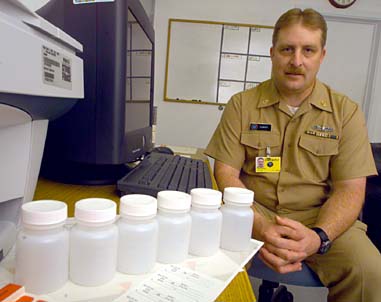
GEORGE F. LEE / GLEE@STARBULLETIN.COM
Sample collection bottles, ID labels and anti-tamper tape line the table in front of Navy Chief Petty Officer Randy Sumner, urinalysis program coordinator at Pearl Harbor.
Navy anti-drug war
proves effectiveRandom screening has helped
cut illegal drug use by sailors
Without warning, Navy Petty Officer Lahaunn Moore was told as he stood in a morning formation in January that it was his turn to submit to one of his command's random drug tests.
"The supervisor just walked up to me and said: 'Moore, it's your turn for urinalysis,'" said Moore, now protocol assistant at the U.S. Pacific Fleet at Pearl Harbor.
Moore, 23, was immediately escorted to a bathroom and given a plastic bottle. The urine sample was then taken to a collection point.
Since 1982, the Navy has been screening all of its sailors for illicit drug use -- for drugs ranging from marijuana, cocaine, to ice and Ecstasy -- under its "zero-tolerance" program. The Navy says, "All personnel found guilty of a single incident of drug use must be processed for administrative separation."
Today, the Navy maintains that fewer sailors are using illegal drugs, noting that less than one half of 1 percent of all urine samples now come back positive. Navy officials say the most likely drug user is a male sailor who has been in the service for less than three years and has not qualified for any specialty.
In 1982, the first year of urinalysis screening, the percent of positive samples was 7.21 percent. The percentage of positive samples this year through April has dropped to 0.47 percent.
Linda Boswell, Pacific Fleet's alcohol and drug control officer, said test results in her command reflect the same downward trend. Urinalysis tests conducted between October and April resulted in 0.43 percent positive samples.
"We see our accomplishment due to our prevention triad: leadership awareness, random urinalysis and prevention education," Boswell said.
Bill Flannery, the Navy's alcohol and drug abuse prevention program manager in Millington, Tenn., said, "The drug testing program in the Navy today is the model by which drug testing programs in the civilian community are designed."
Boswell said a cornerstone of the Navy's drug program is the ability of commanding officers and senior enlisted leaders to influence the actions of their subordinates.
"We ask them to assess their environment," Boswell for risk factors, to determine who are the sailors most at risk."
Under the Navy's screening program, sailors are subject to two possible tests each year.
Each month, 19 to 20 percent of the assigned sailors to a particular command are picked by a computer to be screened, said Lt. Mike Morley, Pacific Fleet spokesman. "There is no warning or excuses," he added.
Morley said the entire command is checked annually.
Moore said during the nearly six years he has been in uniform he can't recall how many tests he has had to take since there were so many. "Last year alone I think I was tested at least three times," Moore said.
Boswell said the drug prevention education program is designed to inform sailors about the consequences they face under the Navy's "zero tolerance" program.
"We try to give them value-based decisions to reject drug and alcohol abuse," she said.
If a sailor flunks an urinalysis test, Morley said, an administration separation board is convened where the sailor can plead his or her case.
Morley said samples drawn in Hawaii are sent to drug-screening labs in San Diego. There are others in Norfolk, Va., and Jacksonville, Fla.
Boswell said Chief of Naval Operations Adm. Vernon Clark has said that he wants to reduce the number of positive tests this year by 25 percent. Clark also wants to increase the numbers of sailors tested, which has steadily climbed from 450,000 in 2001, to 515,000 in 2002, and 577,000 through March 31.
In the Pacific Fleet, 122,142 sailors were tested during the fiscal year which began in October 1998. The following year, 177,505 had to submit to urinalysis. Between October and April, 200,780 sailors in the Pacific Fleet were tested.
Moore said the Navy approach "focuses not on solving the program, but preventing it from happening. It's a great deterrence."
